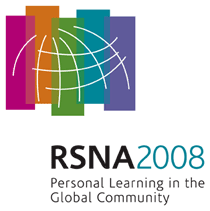
Abstract Archives of the RSNA, 2008
SSC18-09
Experimental Validation of Three-Material Mass-Fraction Decomposition
Scientific Papers
Presented on December 1, 2008
Presented as part of SSC18: Physics (CT: Dual Energy)
Xin Liu PhD, Presenter: Nothing to Disclose
Lifeng Yu PhD, Abstract Co-Author: Research grant, Xoran Technologies, Inc
Andrew Primak PhD, Abstract Co-Author: Research grant, Siemens AG
Cynthia H. McCollough PhD, Abstract Co-Author: Research grant, Siemens AG
Research grant, RTI Electronics AB
Research grant, Bayer AG
Often more than two materials coexist in biological systems, such as iron deposits in a calcified artery (Fe, Ca, tissue) or iron in a fatty liver (Fe, tissue, fat). The purpose of this work was to develop and validate a three-material decomposition algorithm for dual energy CT that is able to quantitate the individual mass-fractions of three materials of known chemical composition.
The proposed algorithm uses a two-step procedure. First, both the effective atomic number and effective density of the mixture are determined using previously described methods (i.e. ρ, Z methods). Second, the calculated effective density is used as an input parameter (i.e. known information) in basis-material decomposition calculations. In this work, both steps were implemented using reconstructed image data. To validate the method, we used a 30cm diameter water phantom containing 5 syringes filled with homogenous mixtures of water, hydroxyapatite [HA: Ca5(PO4)3OH] and aqueous iron nitrate (Ca mass-fraction=0.10, 0.08, 0.07, 0.06, 0.05; Fe mass-fraction=0.009, 0.007, 0.006, 0.005, 0.004) with mixture densities of 1.19, 1.15, 1.12, 1.10, and 1.09 g/cc, respectfully. Using a dual source CT system, low and high-energy images were simultaneously acquired with two different x-ray energy spectra (80 kV and 140 kV). The mean CT numbers of the solutions ranged from 520 to 250 HU at 80 kV and 330 to 150 HU at 140 kV as the mixture density decreased. The proposed algorithm was used to determine the density and mass fractions of HA and Fe.
The mixture densities determined using the proposed dual-energy CT algorithm were in excellent agreement with known values, with a maximum error of less than 3% (mean error = 1.6%). The mass fractions of HA and Fe determined using the proposed dual-energy CT algorithm were in reasonable agreement with known values, with maximum errors of less than 30% (mean error = 13%).
Experiment data demonstrate the ability of the proposed algorithm to determine the mass fraction of three materials of known chemical compositions using dual-energy measurements and without the constraint of volume conservation.
The proposed algorithm provides accurate mass-fraction estimation of three materials using dual-energy CT. It can be used in clinical applications involving separation of three known materials.
Liu, X,
Yu, L,
Primak, A,
McCollough, C,
Experimental Validation of Three-Material Mass-Fraction Decomposition. Radiological Society of North America 2008 Scientific Assembly and Annual Meeting, February 18 - February 20, 2008 ,Chicago IL.
http://archive.rsna.org/2008/6012562.html

